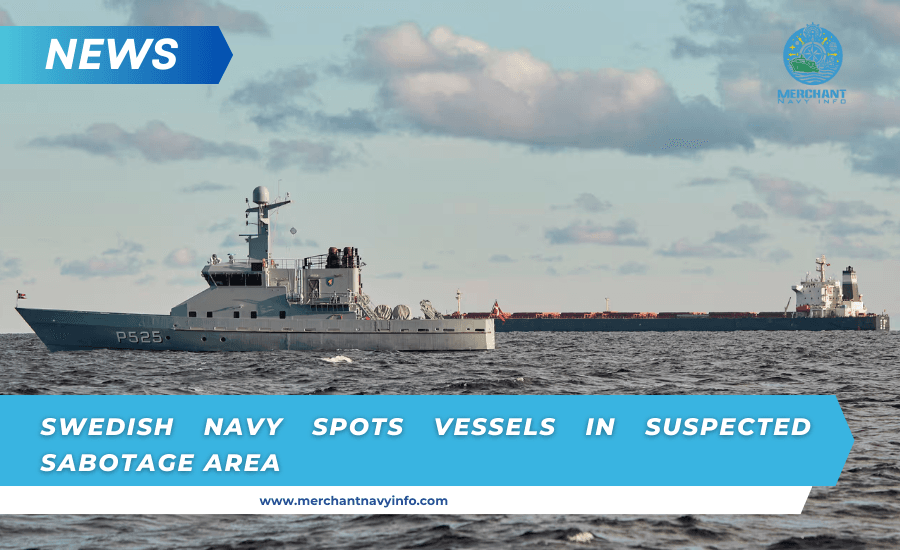
Swedish Navy Identifies Vessels In Area Suspected Of Underwater Cable Sabotage
Investigators collect evidence at two locations in the Baltic Sea region while the Danish Navy tracks the Chinese cargo ship. The Swedish Navy said it has a “roughly 100%” picture of vessels at suspected submarine cable sabotage sites in the Baltic Sea. In contrast, Danish authorities said the Danish Navy monitors a Chinese cargo ship closely.
On Wednesday, a Swedish expert underwater search team went to the site of the Finnish-German cable, one of two damaged underwater optical cables, to collect evidence for Swedish investigators. A cable between Sweden and Lithuania was also damaged.
Maritime authorities said the information collected was confidential to Swedish police and prosecutors but “almost 100% identified” which ships were in the area of the cable break.
Denmark has previously said a warship is next to the Chinese cargo ship “Yiping Sanhao”, anchored in the Baltic Sea between Sweden and Denmark. The ship was tracked after the passage of two cables on Sunday and Monday, which are believed to have been cut in the suspected malicious attack.
The Danish Defence Command said: “The Danish Defence can confirm our presence in the area near the Chinese ship Yiping 3. The Danish Defence has no further comment at this time.”
The cargo ship, owned by Ningbo Yipeng Shipping Company, registered in Ningbo, last visited Ust-Luga in western Russia, near the Estonian border, on November 15, according to tracking data from Vesselfinder.
It was anchored in the Kattegat Strait between Denmark and Sweden overnight from Tuesday to Wednesday.
Alexander Stechintsev, a Russian naval pilot who boarded the ship to guide it out of port, told the Guardian that there was nothing unusual about the ship. An employee of the Ust-Luga Port Authority said he took the ship to a receiving buoy 11 miles offshore and then disembarked. He described the ship, Yiping 3, as “an ordinary cargo ship 225 meters long” with Chinese citizens on board.
“There is nothing unusual about the ship,” he said. A Russian naval database confirms that the Yiping 3 was abandoned on the afternoon of November 15.
Russia denies any involvement in the cable incident. On Wednesday, the Kremlin said that such allegations were “absurd” and that it was ridiculous to accuse Russia without evidence.
Sweden and Finland are jointly investigating the incidents as possible sabotage, with Sweden leading the investigation. Swedish investigators are looking into the possible role of the Chinese vessel, but the Swedish government has not commented, according to the Financial Times. A government source told the Guardian that information about the incident “spread very fast.”
Last year, the anchor of another Chinese ship, the Nyonyo Polar Bear container ship, was found to have damaged a gas pipeline between Finland and Estonia. Authorities have not yet said whether they believe the incident was intentional or accidental. Europeans’ most pressing stories and debates: from identity to economy and environment
Privacy notice: The newsletter may contain information about charities, online advertising and third-party sponsored content. For more information, see our privacy policy. We use Google reCaptcha to protect our site, and the Google Privacy Policy and Terms of Service apply.
Overnight, the Swedish Navy used an unmanned remote-controlled submarine to investigate the southern location of the two cables. However, it warned that this would take “several days” due to challenges with bad weather and possible poor visibility.
Swedish Navy spokesman Jimmy Adamsson said he had asked the navy to support the investigation by Swedish prosecutors and police and to send ships immediately. The navy was asked to collect evidence at two outage sites: one at 100-150 meters (cable between Sweden and Lithuania) and another at 20-40 meters (cable between Finland and Germany). They were also asked to create a picture showing which ships were there at what time.
The navy crews, trained in underwater searches, had previously carried out two similar missions in 2022 when investigating suspected sabotage of the Nord Stream pipeline.
“Yesterday (Tuesday) two navy ships left the Swedish port and headed for the southernmost point of the two ships,” Adamsson said. They worked all night and into the morning. “The weather was a bit bad.”
At any given time, about 4,000 large ships are in the Baltic Sea, transmitting data, electricity, and gas across Europe through a network of undersea cables.
Danish Prime Minister Mette Frederiksen said she was “not surprised” by the possible sabotage. He added: “If the immediate assessment is that this was an act of sabotage and that it came from abroad, then this is clearly dangerous. I am not surprised that this happened.”
German Defense Minister Boris Pistorius has already said he believes the action was sabotage. “No one believes that the cable was damaged accidentally,” he said.
Swedish Civil Protection Minister Carl Oskar Bolin quickly linked the ship’s movements to the cut cable. He added, “The ship’s activities are consistent with this maritime surveillance crime.”
The Finnish Security Intelligence Service (Supo) said it was “too early to assess the cause of the cable damage” but was using its expertise to support other authorities. It is estimated that around 200 underwater cable breaks occur each year worldwide, most often due to human activities such as fishing or anchoring.









